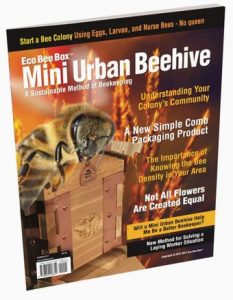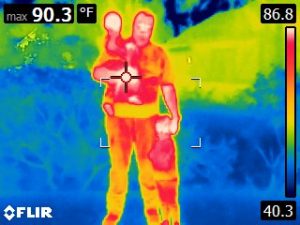The season of winter hive preparation has begun. Understanding the wintering process can be a challenge for many beekeepers. It isn’t a simple one-size-fits-all scenario. Here are a few thoughts about wintering honey bees:
- Bees need winter access to outside for cleansing flights
- If moisture inside the hive rises during the winter months bees will die
- Place your hive in a spot with full sun and protection from wind. The wind that blows into the entrance will kill bees
- An upper entrance can be blocked with propolis, which helps retain heat and control their inside atmosphere but is an emergency exit too when the bottom exit is blocked
- Mice are looking for places with food and shelter during fall and winter, protect your hive from them
- Do not feed 1:1 in fall, feed 2:1 sugar to water
- Prepare candy boards to be placed on hives during mid to late winter. Adding candy boards in fall encourages bees to reside in the upper box, their last position prior to death. Bees need to start fall in the lower box and work their way up during winter
- Bee eat crystallized honey and sugars during winter which has a low moisture content
- Candy can be also placed in the empty drawn comb to be placed in ideal locations for emergency winter food
- Stored honey retains heat while the bees are in a cluster. We suspect that hardened candy does not have the same insulation qualities
- Protein patties encourage brooding, they can be added in late winter or in small portions in the candy-board.
- Wrapping hives with tar paper or cozy’s in areas that get frigid or are windy help but plastic wraps retain moisture and are not suggested
- If you have a Styrofoam or plastic hive consider the moisture challenges due to equipment resistance to moisture and the ability to sweat
- Historically in Utah, a burlap cloth was placed under the lid to wick out moisture but in some areas can wick it in too
- Mite control can be using vaporizing oxalic acid once the snow has fallen
- Do not open your hive during winter unless it is above 40 F or bees are flying
- Thermal imaging can be done in winter by renting a Fleur camera from Home Depot for $40. Look for heat, a low cluster
- Mini colonies can be moved indoor cellars or sheds on days 10 or more degrees below freezing. Too long indoors with warms temps require feeding and cleansing flights
- Bees do not draw wax when cold
- Queens can continue to lay small areas of brood during winter months
- During fall the worker bees expel drones, so don’t be shocked with dead bees showing up around a hive
- The queen begins laying winter bees in fall that can survive all winter
- If bees are indoors where it is warm they need easy access to outside when needed
- We suggest in fall drilling a half-inch hole through the center of deep frames to allow bees to remain in a single type cluster, otherwise large plastic foundations restrict cluster movement in winter
- Ideally, two deep boxes filled with bees and honey is what is suggested for overwintering BUT it is more important to have enough food per capita for winter
- Too large of a space for the bees to control may be detrimental for winter
- We have seen bees survive winter with no lid and in a chimney flue
- Each area requires the beekeeper to become a master of that area. We have seen rain jackets placed on hives in Oregon. In Saskatchewan, Canada hives are protected with hay bales.
- Be patient with your bees in winter, they don’t hibernate, they are lethargic and may appear dead but are not so.
- Dysentery and nosema are risks in winter and are not the same. One is due to being confined and the other is bacteria. Both show signs by bee excrement plastering the external areas of the hive. It can not be treated in winter, have to wait for spring
- Dr. Carson with Complete Bee suggests that in cold climates he claims the best winter bee as being the darkest bees you can find.
A few thoughts on wintering bees from an over-full cranium. Many thoughts on keeping bees can be found in the publication “Mini Urban Beehive”.
 |
Here is a response Albert Chubak gave to a series of questions on bottom board screens for winter, reducing the lower entrance, and popsicle sticks being added under the lid for winter ventilation.
“If you were in Oregon perhaps I would think an open screened bottom may be okay. In Utah the bees need to keep dry and warm. My thought would be why do you think there would be moisture in your hive in the winter months? If the bees could not dehydrate and cap their forage, then consuming it in winter would create moisture. If rain was an issue, then moisture may be a problem. Mostly our winters are relatively dry so to speak, and not that cold. However, the fluctuation in temp is detrimental to their survival. Keeping the temp from varying too much is important. So with that said the ventilations you suggest can be harmful. Historically here in Utah burlap cloth was placed under the lids to wick out moisture but clearly did not allow moisture in due to a large stone that was on top the hive. Wind blocks also prevent cooling. Reducing the entrance seems to me to contradict the other openings you made. I suggest to have the lower entrance fully open allowing flights if needed, as if this closes due to die-offs then a week later the colony is too dead. The big question I am not committed to yet is if I open the top entrance after the bees have propolized it closed in fall. They usually know better than myself. If the bottom is open then the top can remain closed. Again this all would be a different discussion if you were in Oregon or other humid or rainy regions. Sometimes we too have rain in winter in Utah, so a beekeeper has to roll with the conditions and adjust accordingly.” Response given by Albert Chubak in a discussion on a Facebook thread.
Another comment by a Facebookian. David wrote:
“…this is an excellent summation. I am in mid-MD. Going into my 7th year. 18 colonies. I find your comment about putting candy on in mid-to-late winter as opposed to putting candy on in late fall or in December interesting. I think I agree. I have a hive with a glass inner cover and put candy underneath. Last year (which, granted, was warmish) the bees were always at the top. I had a temp/humidity monitor under the glass where it was always in the 70s or high 60s with bees gathering to a dinner plate size at night but expanding to cover all ten top bars during the day. They never left the top to go down below to “cluster.” I think many put candy on after Thanksgiving thinking that it does not hurt to do so. Maybe. Maybe not. But I am thinking that it is a waste of time and sugar to put candy on when the honey remains untouched. Still trying to figure it out.”

